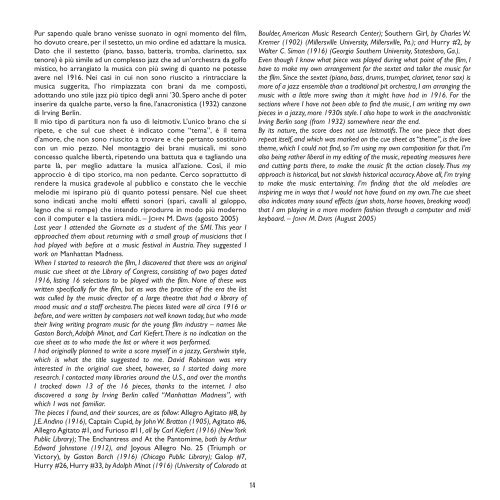Le Giornate del Cinema Muto 2005 Sommario / Contents
Le Giornate del Cinema Muto 2005 Sommario / Contents
Le Giornate del Cinema Muto 2005 Sommario / Contents
You also want an ePaper? Increase the reach of your titles
YUMPU automatically turns print PDFs into web optimized ePapers that Google loves.
Pur sapendo quale brano venisse suonato in ogni momento <strong>del</strong> film,<br />
ho dovuto creare, per il sestetto, un mio ordine ed adattare la musica.<br />
Dato che il sestetto (piano, basso, batteria, tromba, clarinetto, sax<br />
tenore) è più simile ad un complesso jazz che ad un’orchestra da golfo<br />
mistico, ho arrangiato la musica con più swing di quanto ne potesse<br />
avere nel 1916. Nei casi in cui non sono riuscito a rintracciare la<br />
musica suggerita, l’ho rimpiazzata con brani da me composti,<br />
adottando uno stile jazz più tipico degli anni ’30. Spero anche di poter<br />
inserire da qualche parte, verso la fine, l’anacronistica (1932) canzone<br />
di Irving Berlin.<br />
Il mio tipo di partitura non fa uso di leitmotiv. L’unico brano che si<br />
ripete, e che sul cue sheet è indicato come “tema”, è il tema<br />
d’amore, che non sono riuscito a trovare e che pertanto sostituirò<br />
con un mio pezzo. Nel montaggio dei brani musicali, mi sono<br />
concesso qualche libertà, ripetendo una battuta qua e tagliando una<br />
parte là, per meglio adattare la musica all’azione. Così, il mio<br />
approccio è di tipo storico, ma non pedante. Cerco soprattutto di<br />
rendere la musica gradevole al pubblico e constato che le vecchie<br />
melodie mi ispirano più di quanto potessi pensare. Nel cue sheet<br />
sono indicati anche molti effetti sonori (spari, cavalli al galoppo,<br />
legno che si rompe) che intendo riprodurre in modo più moderno<br />
con il computer e la tastiera midi. – JOHN M. DAVIS (agosto <strong>2005</strong>)<br />
Last year I attended the <strong>Giornate</strong> as a student of the SMI. This year I<br />
approached them about returning with a small group of musicians that I<br />
had played with before at a music festival in Austria. They suggested I<br />
work on Manhattan Madness.<br />
When I started to research the film, I discovered that there was an original<br />
music cue sheet at the Library of Congress, consisting of two pages dated<br />
1916, listing 16 selections to be played with the film. None of these was<br />
written specifically for the film, but as was the practice of the era the list<br />
was culled by the music director of a large theatre that had a library of<br />
mood music and a staff orchestra.The pieces listed were all circa 1916 or<br />
before, and were written by composers not well known today, but who made<br />
their living writing program music for the young film industry – names like<br />
Gaston Borch, Adolph Minot, and Carl Kiefert.There is no indication on the<br />
cue sheet as to who made the list or where it was performed.<br />
I had originally planned to write a score myself in a jazzy, Gershwin style,<br />
which is what the title suggested to me. David Robinson was very<br />
interested in the original cue sheet, however, so I started doing more<br />
research. I contacted many libraries around the U.S., and over the months<br />
I tracked down 13 of the 16 pieces, thanks to the internet. I also<br />
discovered a song by Irving Berlin called “Manhattan Madness”, with<br />
which I was not familiar.<br />
The pieces I found, and their sources, are as follow: Allegro Agitato #8,by<br />
J.E.Andino (1916), Captain Cupid, by John W. Bratton (1905), Agitato #6,<br />
Allegro Agitato #1, and Furioso #11, all by Carl Kiefert (1916) (New York<br />
Public Library); The Enchantress and At the Pantomime, both by Arthur<br />
Edward Johnstone (1912), and Joyous Allegro No. 25 (Triumph or<br />
Victory), by Gaston Borch (1916) (Chicago Public Library); Galop #7,<br />
Hurry #26, Hurry #33, by Adolph Minot (1916) (University of Colorado at<br />
14<br />
Boulder, American Music Research Center); Southern Girl, by Charles W.<br />
Kremer (1902) (Millersville University, Millersville, Pa.); and Hurry #2, by<br />
Walter C. Simon (1916) (Georgia Southern University, Statesboro, Ga.).<br />
Even though I know what piece was played during what point of the film, I<br />
have to make my own arrangement for the sextet and tailor the music for<br />
the film. Since the sextet (piano, bass, drums, trumpet, clarinet, tenor sax) is<br />
more of a jazz ensemble than a traditional pit orchestra, I am arranging the<br />
music with a little more swing than it might have had in 1916. For the<br />
sections where I have not been able to find the music, I am writing my own<br />
pieces in a jazzy, more 1930s style. I also hope to work in the anachronistic<br />
Irving Berlin song (from 1932) somewhere near the end.<br />
By its nature, the score does not use leitmotifs. The one piece that does<br />
repeat itself, and which was marked on the cue sheet as “theme”, is the love<br />
theme, which I could not find, so I’m using my own composition for that. I’m<br />
also being rather liberal in my editing of the music, repeating measures here<br />
and cutting parts there, to make the music fit the action closely.Thus my<br />
approach is historical, but not slavish historical accuracy.Above all, I’m trying<br />
to make the music entertaining. I’m finding that the old melodies are<br />
inspiring me in ways that I would not have found on my own.The cue sheet<br />
also indicates many sound effects (gun shots, horse hooves, breaking wood)<br />
that I am playing in a more modern fashion through a computer and midi<br />
keyboard. – JOHN M. DAVIS (August <strong>2005</strong>)
















